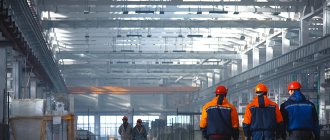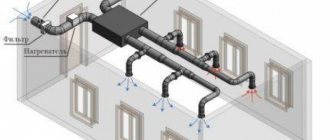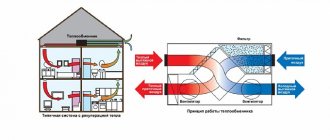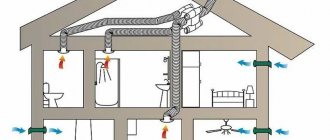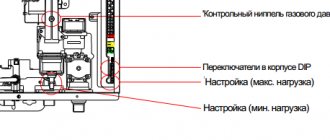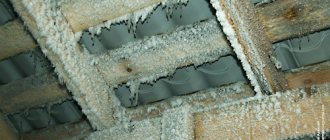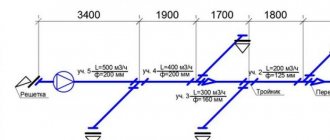Today our story will be devoted to the elements of the heating system, with which many tragic incidents are associated, and first of all we are talking about chimneys. If you have a bathhouse, cottage or residential building where an autonomous boiler is used, then you can potentially suffer from poor draft, which does not remove combustion products outside.
The accumulation of CO in the body can lead to “silent” death. If you want to know how to protect yourself and your loved ones, read the article to the end.
Ventilation and chimneys in a private metal house
What kind of pipe should be for a gas water heater?
The chimney must be
strictly vertical and have at the base a removable pipe or pocket 250 mm deep with a door for cleaning soot. If it is necessary to bypass existing obstacles, a deviation of up to 30° from the vertical is allowed, while the cross-sectional area is maintained, and the offset should not exceed 1 m.
Interesting materials:
How to determine the main and dependent word in a phrase? How to determine the main and dependent word? How to determine the main word in a sentence? How to define the main word? How to determine the main words in phrases? How to determine the grammatical form of a word? How to determine which is the main word in a phrase? How to determine keywords for a site? How to identify keywords in an article? How to define keywords?
Requirements for chimneys and ventilation
The need for ventilation and the standards for its calculation are contained in SNiP 31-01-2003. It indicates air exchange standards for different categories of premises. So, for living rooms this value is small - 3 cubic meters per hour per 1 sq. meter of area. But for bathrooms this figure is already higher - 25 cubic meters per hour. The highest air exchange requirements for kitchens: 60 m3/h for a kitchen with an electric stove, and 100 for a gas stove.
Thus, the rooms from which exhaust air must be removed first are bathrooms, toilets, laundries, boiler rooms and kitchens. At the same time, the presence of mandatory ventilation is established by regulations if you use gas equipment in an open fire: installing a stove in a room without ventilation is strictly prohibited. For equipment with closed fireboxes, a separate chimney must be provided and air flow must be ensured.
Strict requirements are imposed on chimneys, which are set out in SP 7-13130-2013. This is especially true for fire safety, because the temperature range in which they operate is quite large. There are several regulations governing the operation of gas equipment:
- SNiP 31-01-2003;
- SNiP41-01-2003;
- SNiP 42-01-2002;
- SP 31-106-2002;
- SP 42-101-2003.
After analyzing these documents, we can draw a number of conclusions regarding the arrangement of smoke ducts in the house:
Tightness of execution. The channel must not communicate with the premises through which it passes.- A limited set of materials from which a chimney can be made.
- The dimensions of the room where the heating device can be located are regulated: its area should not be less than 7.5 square meters. meters and the minimum ceiling height in it is 2 meters.
- The smoke channel must have a smooth internal surface, without protrusions or depressions.
- Ventilation systems and removal of exhaust gases from heating systems must be checked and, if necessary, cleaned.
Thus, the normal operation of smoke and ventilation ducts depends on two factors. The first one is proper design. The second is the quality of workmanship during construction.
Conclusion
The draft in the chimney and proper ventilation of the premises make it possible to create comfortable and safe living conditions in the apartment and house. We recommend that you do not ignore the proposed recommendations and try to follow them. Ultimately, your health and the health of those who live with you will depend on this.
The video in this article will help you find additional information on this topic.
Did you like the article? Subscribe to our Yandex.Zen channel
Need advice on chimney placement
Question asked by: AlexZander77
Hello!
I have attached a drawing of the house's layout, with the desired location of a brick chimney with ventilation drawn by hand. Question, or rather questions:
- Is it possible to arrange the chimney and boiler in the boiler room like this?
- Isn't the boiler room small in area according to SNIPs?
- Is it possible to place ventilation shafts with a chimney in the same box? If so, what should the cross-section of the box be? And the pipe cross-section?
- The height of the chimney can be equal to the height of the pipes; won’t smoke from the adjacent shafts get into the ventilation and back into the house?
- Is it necessary for the chimney and ventilation to pass through metal pipes in a brick box?
Sorry for the number, I collected all my questions left unanswered on other forums. Additions: solid fuel boiler, coal, firewood. I will run PVC pipes from the kitchen hood and ventilation to the chimney through the cold attic. On the background of the picture there is a grid, a cell of 1 meter by 1 meter. Boiler room 3 x 1.5. Ceiling height 2.6. The external perimeter of the house is 7.4 x 9.2. What else. Our winter is windy, with mostly northeast winds. Steppe. It seems that's it))
System Design Options
Ventilation ducts in a private brick house can have different designs. The design is chosen taking into account the characteristics of the rooms and one feature common to the hood. Along with the exhaust air, heat is also removed. To prevent cooling, a bend in the form of a brick staircase will be included in the ventilation system. It creates a barrier and prevents premature removal of heated air: after being delayed, the air flow has time to partially transfer heat into the room.
Conclusions from the premises
This design is used for arranging complex ventilation. In the upper part of the building, all the channels are combined into a common shaft and discharged through the roof, like a chimney. Its height and diameter depend on the volume of the premises and the distance to the roof ridge.
Wall pipe
A brick chimney is installed in the internal walls.
The air duct is installed directly in the internal wall. Installing ventilation ducts, and even more so chimney wall pipes, in external walls is allowed only in exceptional cases. The wall is in contact with cold outside air. In this case, the exhaust gas, passing through the air duct, cools faster and does not warm the room properly. For the same reason, condensation quickly forms inside the chimney or ventilation duct itself. This reduces traction and accelerates wear, as acid anhydrides are deposited on the walls of the shaft. The wall pipe in the outer wall must be additionally insulated.
A separate chimney is installed for each stove. In exceptional cases, 1 chimney outlet is installed for 2 stoves. A ventilation duct is installed on every 2 chimneys.
The chimney riser ends at the top floor and turns into a regular chimney. The height of the chimney and the head of the ventilation duct depends on the exit location.
Root pipe
A brick chimney on its own foundation
is usually installed in wooden buildings. A brick chimney is erected on its own foundation, and the latter is not adjacent to the foundation of the building. The thickness of the walls is equal to half a brick.
The root pipe can be connected to two hearths. For this purpose, reversible sleeves are installed.
Mounted pipe
Constructed directly on the stove. Experts recommend placing a brick chimney not directly on the neck of the stove, but by first laying a reinforced concrete slab with holes on it. This device allows you to repair the stove in the future without disassembling the chimney.
Installation of smoke and ventilation ducts
Any channel necessarily ends on the roof with a pipe. A lot depends on the correct design of the pipe, first of all - traction, secondly - the service life of the entire channel.
Natural draft is based on the difference in air pressure at different altitudes. This is clearly noticeable in the mountains, but many people think that this difference is small at home. It is really not very large, but it is enough to ensure the release of exhaust air and gases into more rarefied layers.
The requirements for the operation of the pipe are to ensure direct draft and the absence of reverse draft. In order for this work to be flawless, you need to choose the right design solution and determine the height of the pipe.
Pipe height
The minimum height of pipes is specified by regulatory documents. Most often, a scheme is used for this, where the height depends on the distance of the pipe from the ridge. In this case, the ridge pipe and the one located closer than 1.5 meters from it should be 50 cm higher than the ridge. The height of the pipe located at a distance of 1.5 - 3 meters from the ridge cannot be lower than it. Finally, the heights of the more distant pipes should reach a line 10 degrees down from the horizon, if this line is drawn from the ridge.
On flat roofs, the minimum pipe height is 50 cm.
The height of the pipe must be increased in the following cases:
- Presence of downward winds in the place where the house stands;
- High parapet on a flat roof;
- The chimney according to the design is lower than the adjacent building.
At the same time, you should not increase the height of the chimney indefinitely - strong draft will increase fuel consumption.
It is permissible to open ventilation ducts under the roof on the technical floor if the roof has a second light or other openings provided for air outlet.
Redevelopment of the ventilation duct in the apartment
Among those families who live in typical city apartments, there is probably no one who would not want to increase the usable area of the premises, especially when it comes to the traditionally cramped and irrationally planned kitchen area.
Today, there are many ways to solve the problem of cramped space - from expanding the kitchen at the expense of adjacent rooms: a corridor, a storage room, to combining the kitchen and adjacent room into a living room. Much less common are kitchen redevelopments involving moving the kitchen to the location of the corridor or adding a kitchen, balcony or loggia to the room.
All these types of redevelopment can be carried out only after appropriate approval of the changes, which guarantees the safety of living in your apartment and in the apartments of your neighbors. But some apartment owners increase the kitchen area by remodeling and dismantling the ventilation duct, which is strictly prohibited by current building codes.
Advantages of removing the ventilation duct and ventilation duct:
Of course, partial or complete dismantling of the ventilation duct can provide certain advantages, because in addition to the fact that in the resulting niche in the wall you can put a refrigerator, a small cabinet, install shelves, the empty space resulting after remodeling the ventilation duct can become part of the interior, and the kitchen area will gain some zest.
But practice shows that redesigning the ventilation duct, for all its advantages, has unpleasant consequences that outweigh all the benefits. If you are planning to dismantle the ventilation duct, then you should know that the Housing Inspectorate will not approve such actions. Dismantling the ventilation riser deprives your neighbors of air flow, and the ventilation duct is part of the common property, and it will not be possible to turn a blind eye to this when living in an apartment building.
Redevelopment of the ventilation duct. Why can't it be arranged?
Some ventilation systems are built using self-supporting blocks. Simply put, a ventilation shaft consists of many sections stacked on top of each other. It’s easy to imagine what could happen if you “pull out” such a block, say, on the fifth floor - the entire shaft from the sixth and above will be deprived of support and hang on the walls, and apartments below the fifth will be left without fresh air.
It would seem logical to bypass this ban on the ground floor, because there are no neighbors below, and the box can be fixed right under the ceiling, but this is also prohibited, since the ventilation shaft is common property and not part of your apartment. For the same reason, it is strictly forbidden to interfere with the layout of the ventilation system enclosures.
Ventilation duct in an apartment building, photo:
Sometimes would-be builders remove not the entire box in the kitchen, but part of it, hoping that it will continue to function as before. It is worth saying right away that even if the size of the ventilation duct makes you think about reducing its area, partial dismantling is also a violation and is explained by its design. It consists of one large (common) channel and two smaller supply channels.
Photo of the redevelopment of the ventilation duct in the kitchen with violations:
Through small channels, the air rises to a height of three meters from the level of air entry into the exhaust windows, which are usually located in the corner of the kitchen and toilet, and only then enters the common channel. By reducing the cross-section in the exhaust shaft, you create an area of high pressure, which will not allow air to pass from the lower apartments above. The neighbors below will be very grateful for the collective smell from the entire entrance to their home, because “the exhaust air will go directly to them.
If you are just planning to buy an apartment, then when choosing suitable housing you should pay attention to the presence of illegal redevelopment, and especially redevelopment of ventilation, since you will not be able to approve such work in the future “retroactively”, and you will have to eliminate everything at your own expense without permission changes made.
- It is quite simple to identify illegally carried out redevelopment during an inspection - all unauthorized changes are marked with red lines on the BTI floor plan.
- The same scheme applies if you yourself carried out the redevelopment of the ventilation duct in the kitchen.
Registration certificate of the apartment with marked illegal alterations:
Fines and penalties for remodeling a ventilation duct or ventilation duct
Once it becomes known about the unauthorized redevelopment (and sooner or later this will happen), you will be required to pay an administrative fine in the amount of 2,500 rubles, and then you will have to, either at your own expense, eliminate all the consequences of the illegal redevelopment and begin restoring the damaged common property.
In general, an apartment with an illegal redevelopment is deprived of many advantages compared to an apartment without redevelopment or housing where the redevelopment was legalized in a timely manner. For example, such an apartment cannot participate in real estate transactions because it is not legally “clean”. In many situations, in order to eliminate this drawback, it is necessary to legalize the redevelopment retroactively.
Ventilation duct inspection report, photo:
Therefore, avoid any work that may affect the ventilation system. However, it is worth noting that in some standard series of houses, ventilation is located in non-obvious places (for example, in load-bearing walls in II-18 or I209A). And it is not possible to create openings in these walls to combine rooms.
In old buildings, the location of various ventilation shafts can be completely unexpected. They can be located inside brick walls, and this fact sometimes becomes an unpleasant surprise when openings are made without permission. Such openings definitely cannot be saved: they will have to be sealed with the restoration of ventilation.
Dismantling an unused ventilation duct in an old house, photo:
Redevelopment of a ventilation duct in an old house. Dismantling unused ventilation ducts
However, older homes often have chimneys or inoperative ventilation ducts. In principle, it is possible to touch them, but only with the consent of 73% of the residents, since this is common property.
This applies to such changes in the layout of the apartment as, for example, moving or expanding a doorway in a partition, installing or dismantling a partition, remodeling with the organization of a dressing room - most of such work can be agreed upon after it has been carried out. But despite the fact that the Housing Inspectorate often accommodates those who have carried out unauthorized redevelopment in their apartment and often formalizes work already completed, all this does not apply to illegal redevelopment of the ventilation duct in the toilet, kitchen or other places.
The list of redevelopments, which also cannot be agreed upon after they have been carried out, includes work that violates the stability of the building’s structures, for example, redevelopments affecting the load-bearing walls of the house. Changes in the layout that obviously worsen the living conditions in your apartment are also considered prohibited and you will not be able to approve them “retrospectively”.
You should not carry out work without permission if this makes it difficult to access existing risers - the housing inspection will oblige you to return everything to its previous condition before redevelopment is carried out.
Thus, when deciding to remodel your kitchen, if you want to increase the usable area of the kitchen, then you should first of all take care of the legality of your future transformations. To ensure that changes in the layout comply with current building and sanitary standards and do not violate the law, before starting work, you should develop a project for the upcoming redevelopment in an organization with SRO approval, and then obtain written permission to redevelop the premises.
Existing forced exhaust systems in the kitchen
A recirculating hood passes air through a filter and returns it back to the room.
Forced exhaust (ventilation) differs from natural exhaust in that it is more efficient at removing contaminated air. Based on the method of processing air masses, the models on the market are divided into two types:
- Units equipped with filter elements that pass air exhausted to the street through them.
- Exhaust devices operating on the principle of recycling (reuse).
In the first samples, the air after cleaning is not retained in the room and is discharged outside. Models of the second type contain built-in carbon filters, after which the cleaned masses are returned to the kitchen. To increase the efficiency of ventilation, the location of the hood above the gas stove is important. First of all, this concerns the height of its removal from the heating plane. According to regulatory requirements, this figure for gas stoves should not be less than 75 cm. This distance will protect the unit from thermal radiation and will not affect the operation of heating equipment.
see also
- Engine crankcase ventilation system
- Calculation of home ventilation
- Do-it-yourself ventilation in the toilet in the country
- Ventilation for an apartment
- Job Responsibilities of an HVAC Engineer
- DIY ventilation from plastic pipes
- Natural ventilation system in a wooden house
- Cottage ventilation project
- Check valve for ventilation 315
- Automation panel for supply ventilation
- Plastic exhaust pipes for ventilation
Technical features of channel laying
It is recommended to lay the chimney parallel to the ventilation ducts.
The construction of the ducts is carried out in accordance with the rules of SNiP:
- The construction of air ducts of any type without an approved design is strictly prohibited.
- Brickwork of smoke and ventilation ducts at the same time is prohibited. They are arranged separately.
- It is recommended to install the ventilation duct parallel to the chimney. Combustion products heat the air in the ventilation duct, which improves draft.
- The masonry depends on the thickness of the wall. With a thickness of 380 mm, the masonry is single-row, with a thickness of 640 mm - double-row.
The dimensions and nature of the masonry depend on the power of the heating system, the area of the room, and the purpose of the building. This is important when building a brick channel: after all, its parameters depend on the parameters of the brick.
Materials and device
The channels in the house are represented by an intra-house network and an outlet pipe through which waste gases are removed to the street.
According to its design, this system can be made in several versions:
- Outlets from the premises, connecting at the top of the building with the subsequent installation of a light pipe on the roof, are used for ventilation;
- A wall pipe that combines both the functions of a load-bearing wall and a pipe containing ventilation and smoke ducts;
- A root pipe that performs only this function and is placed on the foundation;
- An attached pipe, which is a continuation of the stove chimney.
In addition, a combination of certain technologies is possible. Thus, prefabricated chimneys and ventilation may well be packed into the masonry of the wall.
Smoke and ventilation ducts are made from various materials, each of which has its own advantages and disadvantages, as well as areas of application established by standards and practice.
Brick
This is the oldest and most traditional material. It is time-tested and versatile - it can be used to make both ventilation ducts and chimneys for any type of fuel.
The advantages of brick chimneys are enormous. They are mechanically stable, capable of acting as a second heating device on the upper floors (if they come from a stove, fireplace or boiler) and are fireproof. But all these qualities will not manifest themselves if you do not follow a number of rules when constructing them. These are the rules:
- Only solid ceramic single bricks are suitable for channels. It is strictly forbidden to use silicate or hollow ones for these purposes. It should not contain cracks. If this rule is not followed, the channel will be destroyed, and this is especially true for chimneys, where there is a high temperature factor.
- The cross-section of such a channel is rectangular, which does not have a very good effect on traction. To compensate for this drawback, the height of the pipe must be calculated carefully.
- The inner surface of the channel must be perfectly flat. To do this, when laying, mop with a special tool or mitten. If this condition is not met, soot, condensation and sulfur oxide (this product is often formed during the combustion of an odorant - a substance added to the gas to control leaks) settle on the walls. In the future, it leads to the destruction of the channel, and especially its upper part - the pipe.
- All seams in the masonry must be sealed and completely filled with mortar (in hot areas - with clay or a special mixture).
- If you are making a channel in an external wall, it must be insulated. Polystyrene is quite suitable for ventilation, and the smoke channel is insulated with cotton wool. If this is not done, the outer surface of the wall will cool the channel, which will reduce the draft.
Thus, the construction of such channels and pipes requires accuracy and professionalism; the laying of channels and pipes by masons is paid at an increased rate.
Prefabricated single-circuit galvanized and steel systems
Initially, this technology was used in industrial premises, as it made it possible to remove waste materials (dust, gases) directly from workplaces. With high ceilings, it is not possible to provide this outlet with wall ducts, and if you consider that some equipment requires direct connection to ventilation, this choice becomes understandable.
Click to enlarge the full diagram Nowadays, such systems are increasingly used in residential and public buildings, since they allow you to arrange the necessary premises almost anywhere, regardless of the original project. This is especially true for buildings where premises are leased to different organizations, and they were built for one purpose (for example, a former factory office). They are also popular with private developers: they do not need to think about how to more rationally place premises in order to build fewer pipes.

